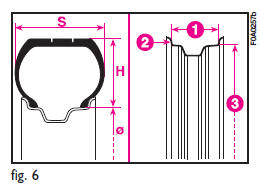RIMS AND TYRES
High resistance printed steel rims of alloy rims.
Tubeless tyres with radial carcass.
The homologated tyres are listed in the log book.
IMPORTANT
In the event of discrepancies between the information provided in this Owner Handbook and the Log Book, consider the specifications shown in the Log Book only.
To ensure safety of the vehicle in movement, it must be fitted with tyres of specified size and of the same make and type on all wheels.
IMPORTANT
Do not use inner tubes with tubeless tyres.
Do not fasten alloy wheels with the steel wheel bolts and vice versa. For details on the compatibility between rims and bolts, see “If a tyre is punctured” in section “In an emergency”
SPARE WHEEL
Pressed steel rim.
Tubeless tyre.
SNOW CHAINS
Only use low profile chains, see “Snow chains”.
WHEEL GEOMETRY
Front wheel toe-in measured from rim to rim: 0 ± 1 mm.
The values refer to the vehicle in running order.
UNDERSTANDING TYRE MARKING
The following are the necessary indications to understand the meaning of the markings on the tyre.

185 = Nominal width (S, distance between sidewalls in mm).
65 = Height/width ratio (H/S, as a percentage).
R = Radial tyre.
15 = Rim nominal diameter in inches (Ø).
88 = Load rating.
T = Maximum speed rating.
Maximum speed rating
Q =up to 160 km/h.
R =up to 170 km/h.
S =up to 180 km/h.
T =up to 190 km/h.
U =up to 200 km/h.
H =up to 210 km/h.
V =up to 240 km/h.
Maximum speed rating for snow tyres
Q M+S = up to 160 km/h
T M+S = up to 190 km/h
H M+S = up to 240 km/h

UNDERSTANDING RIM MARKINGS
The following are the necessary indications to understand the meaning of the markings on the rim.

51/2 = rim width in inches (1)
J = rim drop centre outline (side projection where the tyre bead rests) (2)
15 = rim nominal diameter in inches (corresponds to diameter of the tyre to be
mounted) (3 = Ø)
H2 = “hump” shape and number (relief on the circumference holding the tubeless tyre bead on the rim)

(*) Tyres with load and speed index equal to or higher than the specified values
are admitted
(**) When replacing tyres, you are however recommended to adopt tyres with load and speed ratings equal to or higher than those of the factory-fitted tyres.
COLD INFLATION PRESSURES (bar)

With warm tyres the pressure should be +0.3 bar in relation to the prescribed
value. Check again the correct pressure when the tyres are cold.
(*) Up to 3 people + 50 kg.
See also:
Cheap running that respects the environment
Environmental protection has been one of the guiding principles in the production
of the Fiat Doblò. It is no accident that its pollution control equipment is much
more effective than that ...
Recirculation
Move slider (B) to .
This function is particularly useful when the outside air is heavily polluted
(in a traffic jam, tunnel, etc.). However, it is better not to use it for long periods,
especial ...
21. Electronic Stability Control OFF (ESC OFF)Indicator Light
This light indicates the Electronic Stability Control system (ESC) has been turned
off by the driver. ...


